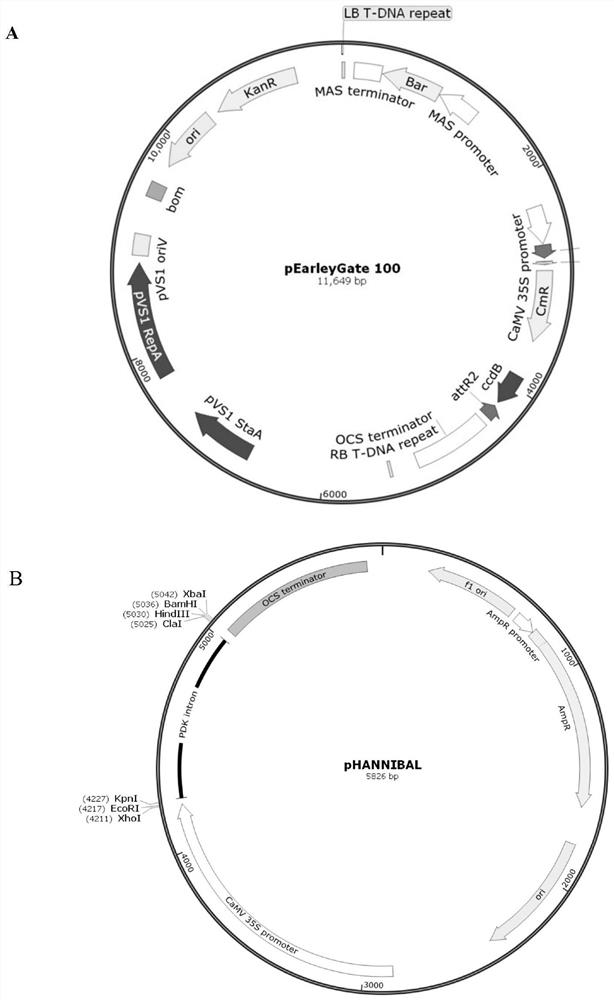Plant expression vector for targeted silence of phytophthora capsici cellulose synthase 3 and application of plant expression vector
A plant expression vector and cellulose synthase technology, applied in the field of agricultural biology, can solve problems such as undiscovered plant diseases, and achieve the effects of delaying the generation of drug resistance, reducing the amount of use, and being beneficial to environmental protection
- Summary
- Abstract
- Description
- Claims
- Application Information
AI Technical Summary
Problems solved by technology
Method used
Image
Examples
Embodiment 1
[0038] Example 1 Sequence source for inhibiting the expression of Phytophthora capsicum oxysterol protein 1 gene of the present invention
[0039] The sequences in the two plant expression vectors of the present invention are derived from different regions of the cDNA sequence of PcCes3, and the sequence is shown in SEQ ID No. Therefore, it can be used as a plant expression vector for enhancing the resistance of plants to Phytophthora capsicum. The cDNA sequence of PcCes3 was derived from the gene numbered JX905357 in the database (GenBank) of Phytophthora capsici.
[0040] The 1801-2602 cDNA sequence of PcCes3, a total of 802 nucleotides (sequence 2 in the sequence table), was selected as the expression sequence of the plant expression vector with the long loop hairpin structure, and the 3005-3559 555 nucleotide sequence (the sequence in the sequence table). 1) As a plant expression vector with a short loop hairpin structure, the required amplification primers are shown in T...
Embodiment 2
[0044] Example 2 Construction of plant expression vector of the present invention
[0045] The primers involved in amplifying the sequences of the present invention are entrusted to the Synthesis Biosynthesis, and the sequences are obtained by amplification using Q5 High Fidelity DNA Polymerases (NEB), which are recovered by gel electrophoresis for vector construction.
[0046] For the short loop hairpin structure vector, the fragment described in sequence 1 (with Phytophthora capsici as a template, and the fragments obtained by amplification with pENsenseC5F and pENsenseC5R in Table 2 as primers were obtained by double digestion with Cla I and EcoR I) To insert between the pENTR1a plasmid restriction site Cla I and EcoR I, after PCR, sequencing, restriction enzyme digestion, electrophoresis verification, the fragment described in sequence 1 (with Phytophthora capsici For template, take pENantisenseC5F and pENantisenseC5R in table 2 as primer amplification obtained fragment ob...
Embodiment 3
[0051] Example 3 Using the plant expression vector involved in the present invention to construct a transgenic plant
[0052] Test plants and bacterial liquid: aseptically cultured tobacco seedlings, Agrobacterium tumefaciens strain GV3101 containing the plant expression vector involved in the present invention.
[0053] Test medium:
[0054] (1) 1 / 2 MS solid medium: MS (Murashige & Skoog medium) 2.2g, sucrose 30g, stir and dissolve, adjust pH to 5.6-5.8 with NaOH, add 8g agar to make up to 1L, sterilize at high temperature and autoclave.
[0055](2) MS solid (liquid) pre-medium: MS 4.44g, MES 2.1235g, sucrose 30g, after stirring and dissolving, adjust pH to 5.8 with NaOH, add 2.4g Phytogel, 1mL 6-BA (1mg / mL) After autoclaving, 1 mL of acetosyringone (AS, 100 μM), 1 mL of naphthalene acetic acid (NAA, 1 mg / mL) were added, and no phytogel was added to the liquid medium.
[0056] (3) Screening medium (budding): MS 4.44g, sucrose 30g, stir and dissolve, adjust pH to 5.8 with N...
PUM
 Login to View More
Login to View More Abstract
Description
Claims
Application Information
 Login to View More
Login to View More - R&D
- Intellectual Property
- Life Sciences
- Materials
- Tech Scout
- Unparalleled Data Quality
- Higher Quality Content
- 60% Fewer Hallucinations
Browse by: Latest US Patents, China's latest patents, Technical Efficacy Thesaurus, Application Domain, Technology Topic, Popular Technical Reports.
© 2025 PatSnap. All rights reserved.Legal|Privacy policy|Modern Slavery Act Transparency Statement|Sitemap|About US| Contact US: help@patsnap.com



